A Low-Noise Direct Incremental A/D Converter for FET-Based THz Imaging Detectors
Abstract
:1. Introduction
2. Antenna-Coupled FET Detector
2.1. FET-Based THz Detector
2.2. On-Chip Bow-Tie Antenna Design
3. THz Readout Chain Design
3.1. Parametric Chopper Amplification
3.2. Continuous-Time Incremental Conversion
4. THz Characterization and Measurements
4.1. Electrical Measurements of the Readout Chain
4.2. THz Experimental Setup
4.3. Antenna-Coupled FET Detector Measurements
4.4. Readout Responsivity and NEP Measurements
4.5. THz Imaging
5. Conclusions
Author Contributions
Conflicts of Interest
References
- Jansen, C.; Wietzke, S.; Peters, O.; Scheller, M.; Vieweg, N.; Salhi, M.; Krumbholz, N.; Jördens, C.; Hochrein, T.; Koch, M. Terahertz imaging: applications and perspectives. Appl. Opt. 2010, 10, E48–E57. [Google Scholar] [CrossRef] [PubMed]
- Siege, P.H. Terahertz technology. IEEE Trans. Microw. Theory Technol. 2002, 50, 910–928. [Google Scholar] [CrossRef]
- Federici, J.F.; Schulkin, B.; Huang, F.; Gary, D.; Barat, R.; Oliveira, F.; Zimdars, D. THz imaging and sensing for security applications–explosives, weapons and drugs. Semicond. Sci. Technol. 2011, 20, S266–S280. [Google Scholar] [CrossRef]
- Ajito, K.; Ueno, Y. THz chemical imaging for biological applications. IEEE Trans. Terahertz Sci. Technol. 2011, 1, 293–300. [Google Scholar] [CrossRef]
- Gowen, A.A.; O’Sullivan, C.; O’Donnell, C.P. Terahertz time domain spectroscopy and imaging: emerging techniques for food process monitoring and quality control. Trends Food Sci. Technol. 2012, 25, 40–46. [Google Scholar] [CrossRef]
- Rutz, F.; Koch, M.; Khare, S.; Moneke, M.; Richter, H.; Ewert, U. Terahertz quality control of polymeric products. Int. J. Infrared Millim. Waves 2007, 27, 547–556. [Google Scholar] [CrossRef]
- Burford, N.M.; El-Shenawee, M.O.; O’Neal, C.B.; Olejniczak, K.J. Terahertz imaging for nondestructive evaluation of packaged power electronic devices. Int. J. Emerg. Technol. Adv. Eng. 2014, 4, 395–401. [Google Scholar]
- Friederich, F.; Spiegel, W.; Bauer, M.; Meng, F.; Thomson, M.; Boppel, S.; Lisauskas, A.; Hils, B.; Krozer, V.; Keil, A.; et al. THz active imaging systems with real-time capabilities. IEEE Trans. Terahertz Sci. Technol. 2011, 1, 183–200. [Google Scholar] [CrossRef]
- Oden, J.; Meilhan, J.; Lalanne-Dera, J.; Roux, J.-F.; Garet, F.; Coutaz, J.-L.; Simoens, F. Imaging of broadband terahertz beams using an array of antenna-coupled microbolometers operating at room temperature. Opt. Express 2013, 21, 4817–4825. [Google Scholar] [CrossRef] [PubMed]
- Han, R.; Zhang, Y.; Kim, Y.; Kim, D.Y.; Shichijo, H.; Afshari, E.; Kenneth, K.O. Active terahertz imaging using Schottky diodes in CMOS: Array and 860-GHz pixel. IEEE J. Solid State Circuits 2013, 48, 2296–2308. [Google Scholar] [CrossRef]
- Lisauskas, A.; Bauer, M.; Boppel, S.; Mundt, M.; Khamaisi, B.; Socher, E.; Venckevičius, R.; Minkevičius, L.; Kašalynas, I.; Seliuta, D.; et al. Exploration of terahertz imaging with silicon MOSFETs. Int. J. Infrared Millim. Terahertz Waves 2014, 35, 63–80. [Google Scholar] [CrossRef]
- Han, R.; Zhang, Y.; Coquillat, D.; Videlier, H.; Knap, W.; Brown, E.; Kenneth, K.O. 280-GHz Schottky diode detector in 130-nm digital CMOS. Proc. IEEE Custom Integr. Circuits 2010, 46, 1968–1976. [Google Scholar]
- Öjefors, E.; Pfeiffer, U.R.; Lisauskas, A.; Roskos, H.G. A 0.65 THz focal-plane array in a quarter-micron CMOS process technology. IEEE J. Solid State Circuits 2009, 44, 1968–1976. [Google Scholar] [CrossRef]
- Al Hadi, R.; Sherry, H.; Grzyb, J.; Zhao, Y.; Forster, W.; Keller, H.M.; Cathelin, A.; Kaiser, A.; Pfeiffer, U.R. A 1 k-Pixel video camera for 0.7–1.1 terahertz Imaging applications in 65-nm CMOS. IEEE J. Solid State Circuits 2012, 47, 2999–3012. [Google Scholar] [CrossRef]
- Boukhayma, A.; Dupret, A.; Rostaing, J.P.; Enz, C. A low-noise CMOS THz imager based on source modulation and an in-pixel high-Q passive switched-capacitor N-path filter. Sensors 2016, 16, 325. [Google Scholar] [CrossRef] [PubMed]
- Liu, Z.; Liu, L.; Yang, J.; Wu, N.A. CMOS Fully Integrated 860-GHz Terahertz Sensor. IEEE Trans. Terahertz Sci. Technol. 2017, 7, 455–465. [Google Scholar] [CrossRef]
- Khatib, M.; Perenzoni, M.; Stoppa, D. A noise-efficient, in-pixel readout for FET-based THz detectors with direct incremental A/D conversion. In Proceedings of the 43rd IEEE European Solid State Circuits Conference, Leuven, Belgium, 11–14 September 2017; pp. 23–26. [Google Scholar]
- Khatib, M.; Perenzoni, M.; Stoppa, D. A CMOS 0.15-μm in-pixel noise reduction technique for readout of antenna-coupled FET-based THz detectors. In Proceedings of the 41st International Conference on Infrared, Millimeter, and Terahertz waves (IRMMW-THz), Copenhagen, Denmark, 25–30 September 2016; pp. 1–2. [Google Scholar]
- Tauk, R.; Teppe, F.; Boubanga, S.; Coquillat, D.; Knap, W. Plasma wave detection of terahertz radiation by silicon field effects transistors: responsivity and noise equivalent power. Appl. Phys. Lett. 2006, 89, 253511. [Google Scholar] [CrossRef]
- Lisauskas, A.; Pfeiffer, U.; Öjefors, E.; Bolìvar, P.H.; Glaab, D.; Roskos, H.G. Rational design of high-responsivity detectors of terahertz radiation based on distributed self-mixing in silicon field-effect transistors. J. Appl. Phys. 2009, 105, 114511. [Google Scholar] [CrossRef]
- Grzyb, J.; Sherry, H.; Cathelin, A.; Kaiser, A.; Pfeiffer, U.R. On the co-design between on-chip antennas and THz MOSFET direct detectors in CMOS technology. In Proceedings of the 2012 37th International Conference on Infrared, Millimeter, and Terahertz Waves (IRMMW-THz), Wollongong, NSW, Australia, 23–28 September 2012; pp. 1–3. [Google Scholar]
- Boppel, S.; Lisauskas, A.; Mundt, M.; Seliuta, D.; Minkevicius, L.; Kasalynas, I.; Valusis, G.; Mittendorff, M.; Winnerl, S.; Krozer, V.; et al. CMOS integrated antenna-coupled field-effect-transistors for the detection of radiation from 0.2 to 4.3 THz. IEEE Trans. Microw. Theory Technol. 2012, 60, 3834–3843. [Google Scholar] [CrossRef]
- Perenzoni, M.; Cavallo, D. Design of an efficient 900 GHz antenna in standard CMOS technology for imaging arrays. In Proceedings of the 2015 9th European Conference on Antennas and Propagation (EuCAP), Lisbon, Portugal, 13–17 April 2015; pp. 1–2. [Google Scholar]
- Ranganathan, S.; Tsividis, Y. A MOS capacitor-based discrete-time parametric amplifier with 1.2 V output swing and 3 nW power dissipation. In Proceedings of the 2003 IEEE International Solid-State Circuits Conference, San Francisco, CA, USA, 13 February 2003; pp. 406–502. [Google Scholar]
- Tsividis, Y.; Suyama, K. Strange ways to use the MOSFET. In Proceedings of the 1997 IEEE International Symposium on Circuits and Systems, Hong Kong, 12 June 1997; pp. 449–452. [Google Scholar]
- Tao, S.; Rusu, A. A power-efficient continuous-time incremental sigma-delta ADC for neural recording systems. IEEE Trans. Circuits Syst. I Regul. Pap. 2015, 62, 1489–1498. [Google Scholar] [CrossRef]
- Markus, J.; Silva, J.; Temes, G.C. Theory and applications of incremental ΔΣ converters. IEEE Trans. Circuits Syst. I Regul. Pap. 2004, 51, 678–690. [Google Scholar] [CrossRef]
- Liang, J.; Johns, D.A. A frequency-scalable 15-bit incremental ADC for low power sensor applications. In Proceedings of the 2010 IEEE International Symposium on Circuits and Systems (ISCAS), Paris, France, 30 May–2 June 2010; pp. 2418–2421. [Google Scholar]
- Khatib, M.; Perenzoni, M. Pixel-level continuous-time incremental sigma-delta A/D converter for THz sensors. In Proceedings of the Optical Sensing and Detection IV, Brussels, Belgium, 3–7 April 2016. [Google Scholar]
- Kwan, T.; Martin, K.W. An adaptive analog continuous-time CMOS biquadratic filter. IEEE J. Solid State Circuits 1991, 26, 859–867. [Google Scholar] [CrossRef]
- Willingham, S.D.; Martin, K.W.; Ganesan, A. A BiCMOS low-distortion 8 MHz low-pass filter. IEEE J. Solid State Circuits 1993, 28, 1234–1245. [Google Scholar] [CrossRef]
- Allen, P.E.; Holberg, D.R. CMOS Analog Circuit Design, 2nd ed.; Oxford University Press: New York, NY, USA, 2002. [Google Scholar]
- Enz, C.; Vittoz, E.A.; Krummenacher, F. A CMOS chopper amplifier. IEEE J. Solid State Circuits 1987, 22, 335–342. [Google Scholar] [CrossRef]
- Ali, M.; Perenzoni, M.; Stoppa, D. A methodology to measure input power and effective area for characterization of direct THz detectors. IEEE Trans. Instrum. Meas. 2016, 65, 1225–1231. [Google Scholar] [CrossRef]
- Sakowicz, M.; Lifshits, M.B.; Klimenko, O.A.; Schuster, F.; Coquillat, D.; Teppe, F.; Knap, W. Terahertz responsivity of field effect transistors versus their static channel conductivity and loading effects. J. Appl. Phys. 2011, 110, 054512. [Google Scholar] [CrossRef]
- Di Gaspare, A.; Casini, R.; Foglietti, V.; Giliberti, V.; Giovine, E.; Ortolani, M. Terahertz current oscillations in a gated two-dimensional electron gas with antenna integrated at the channel ends. Appl. Phys. Lett. 2012, 100, 203504. [Google Scholar] [CrossRef]

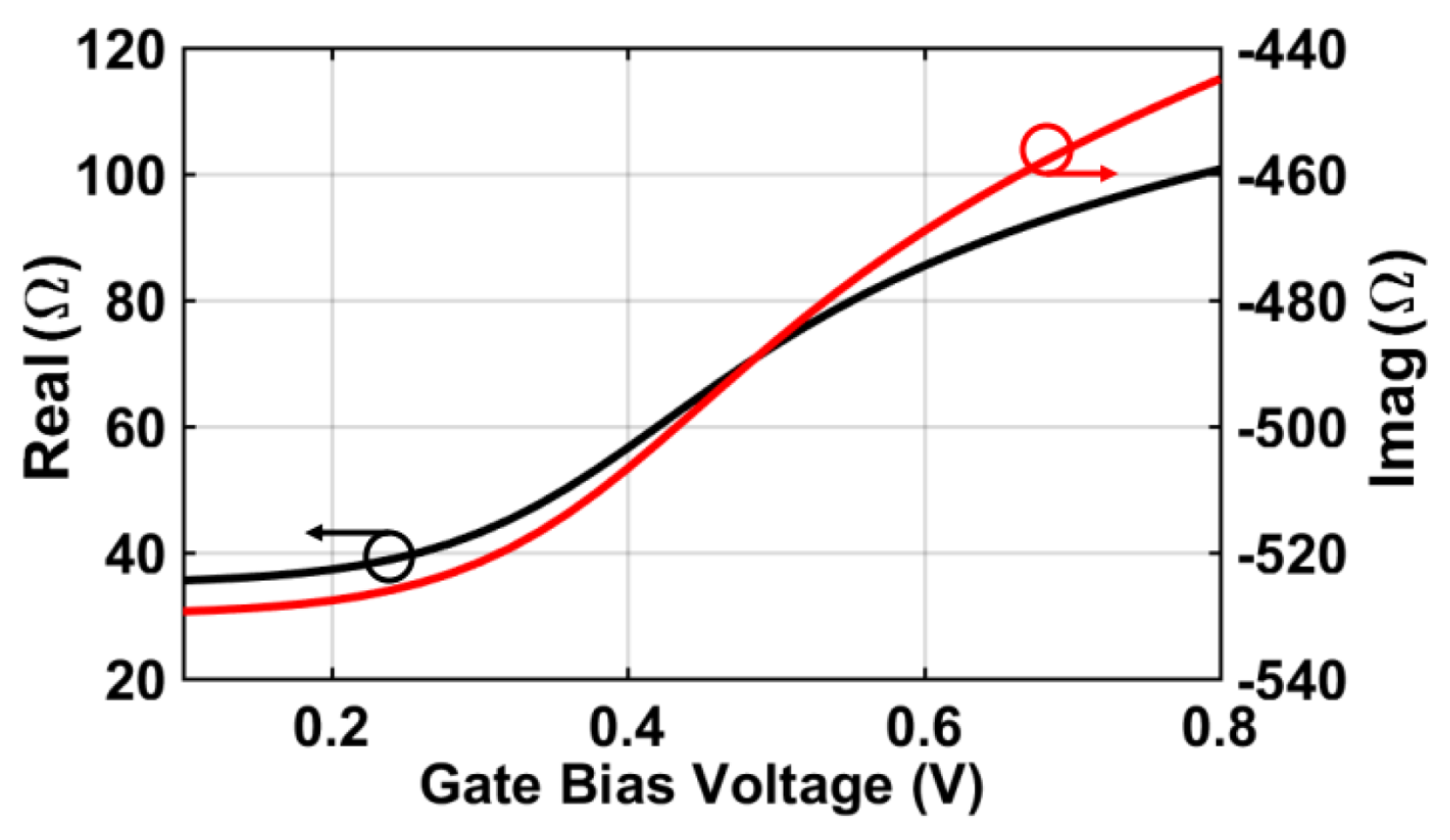
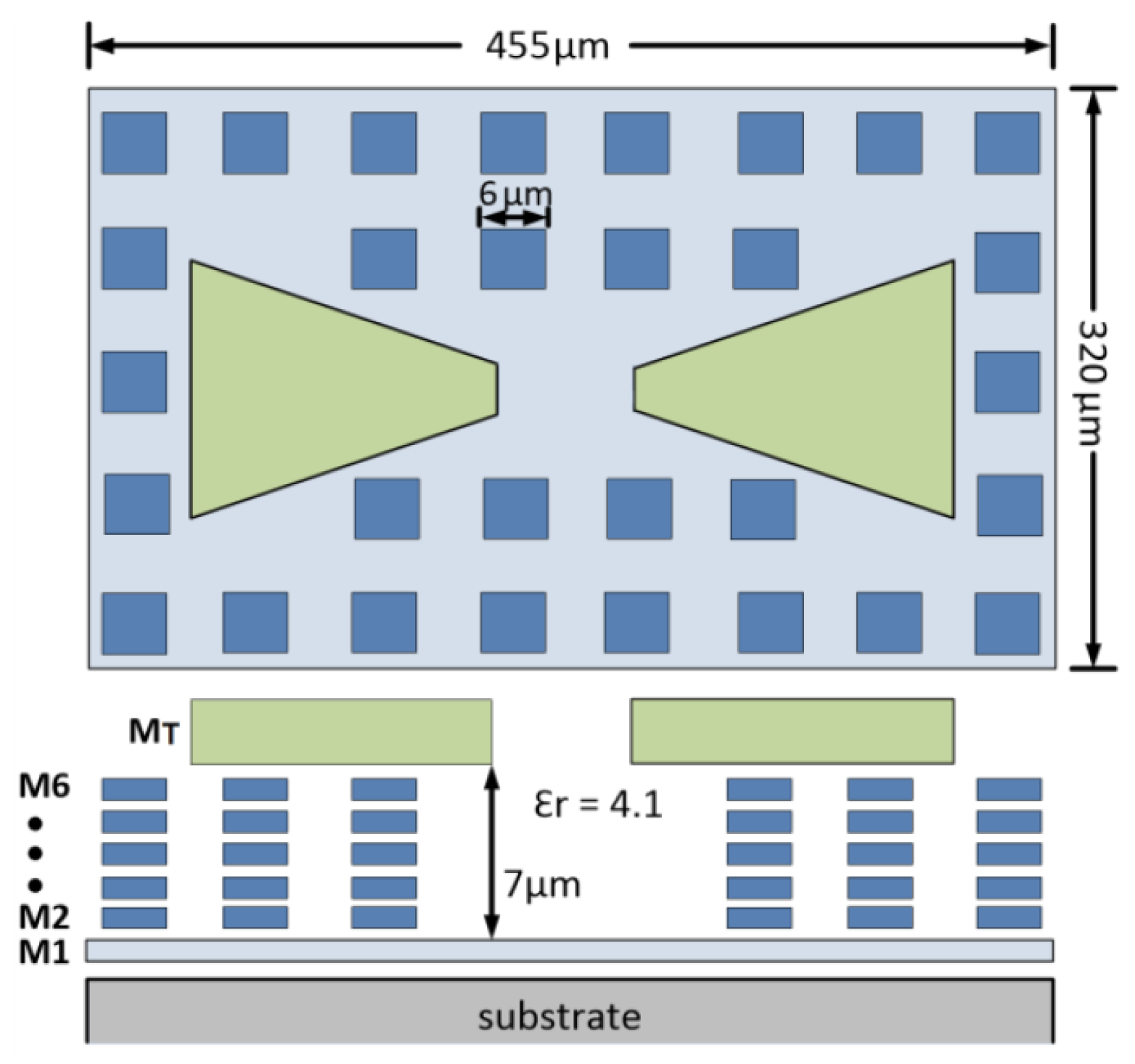


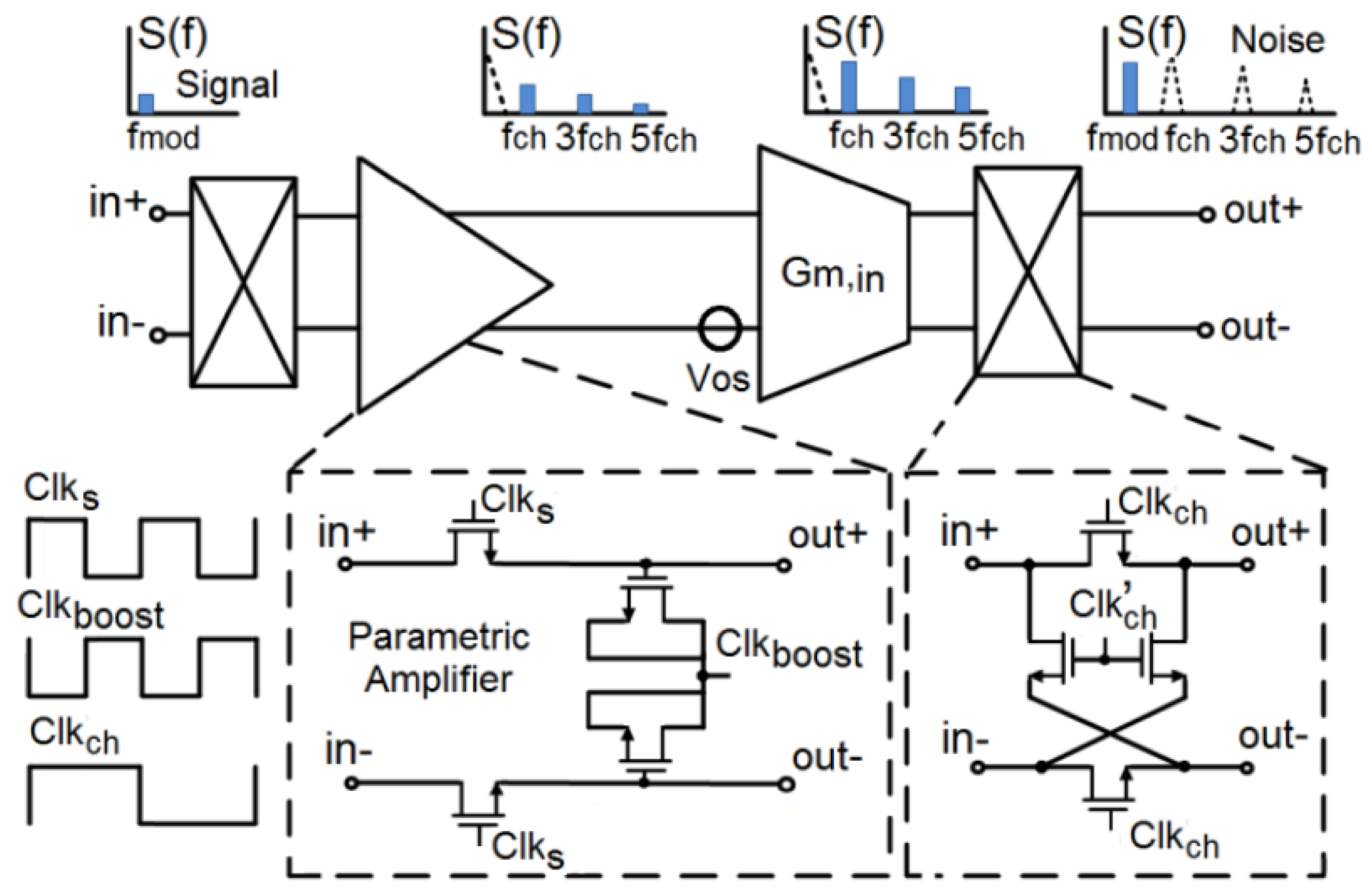
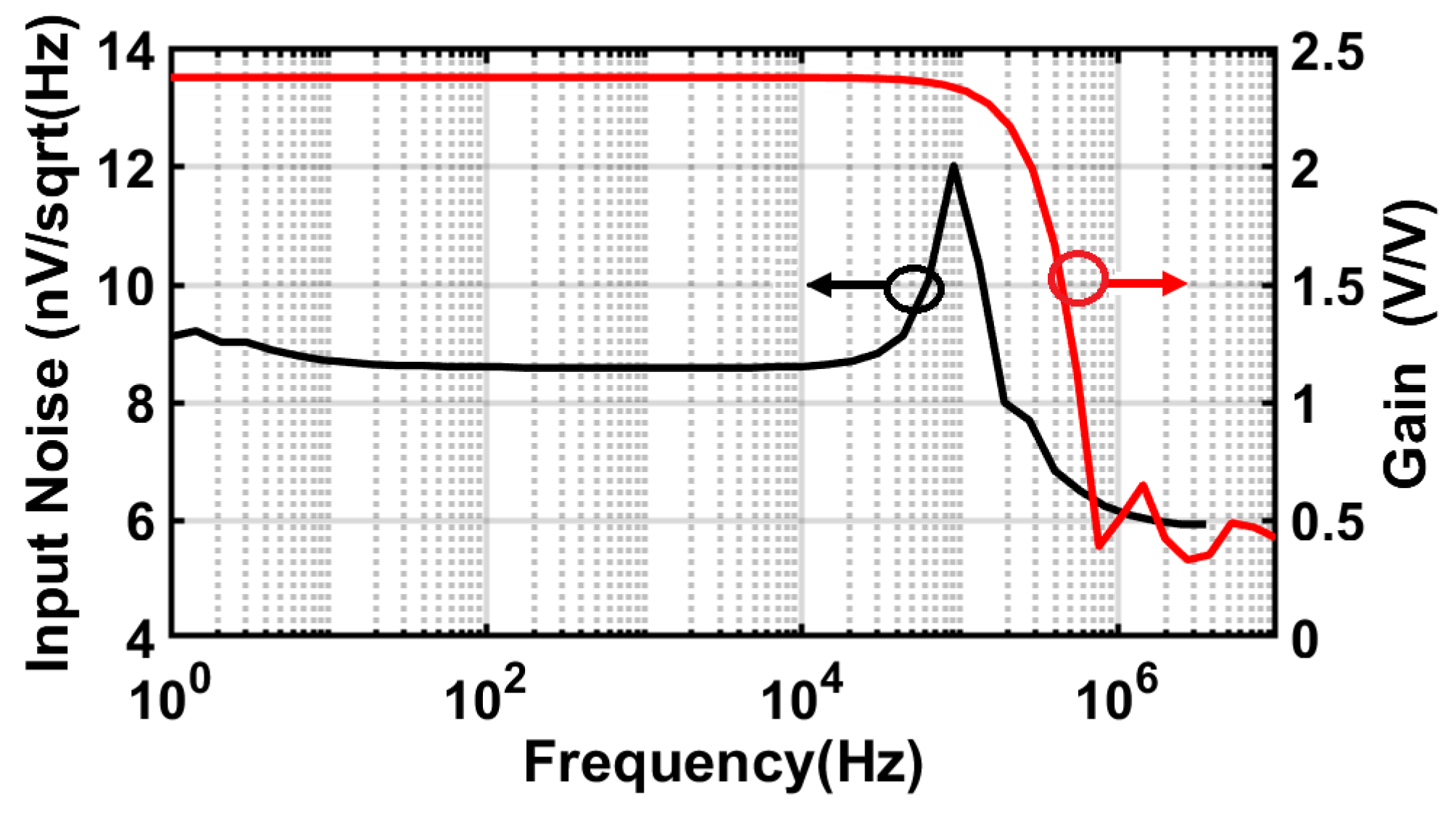


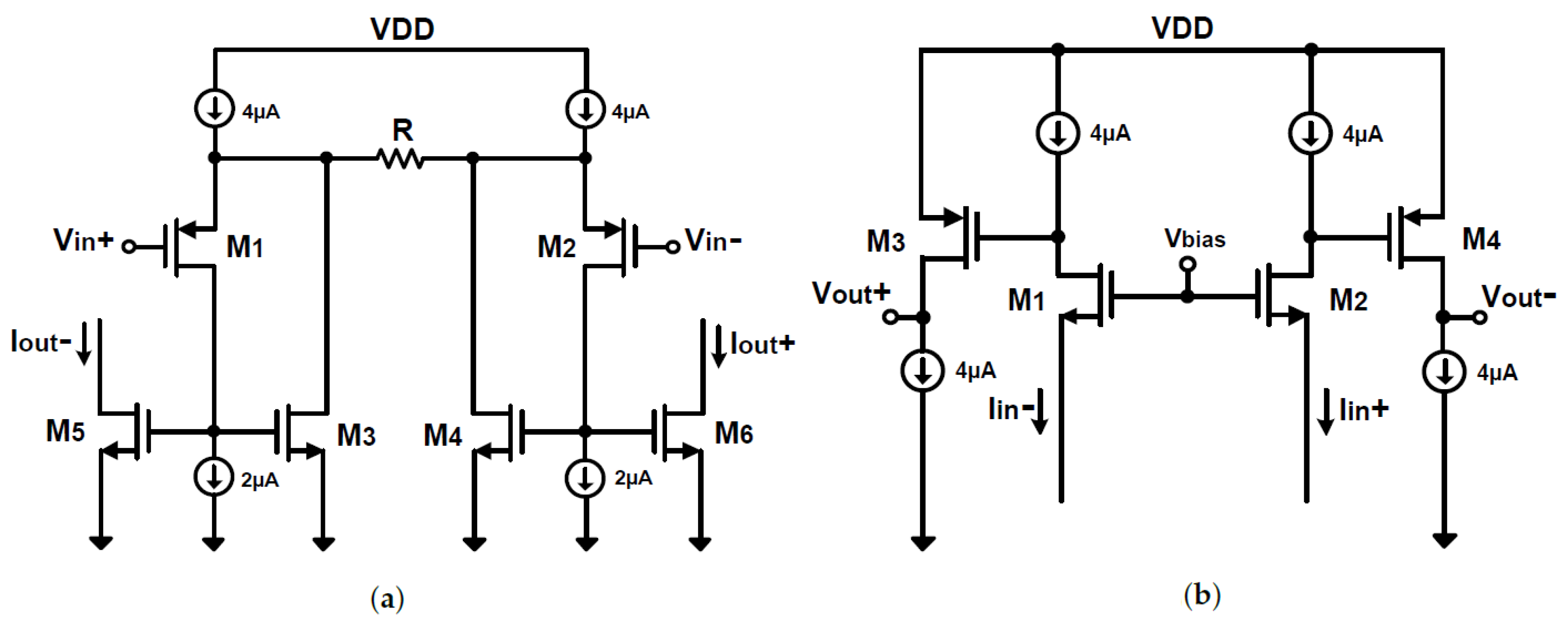
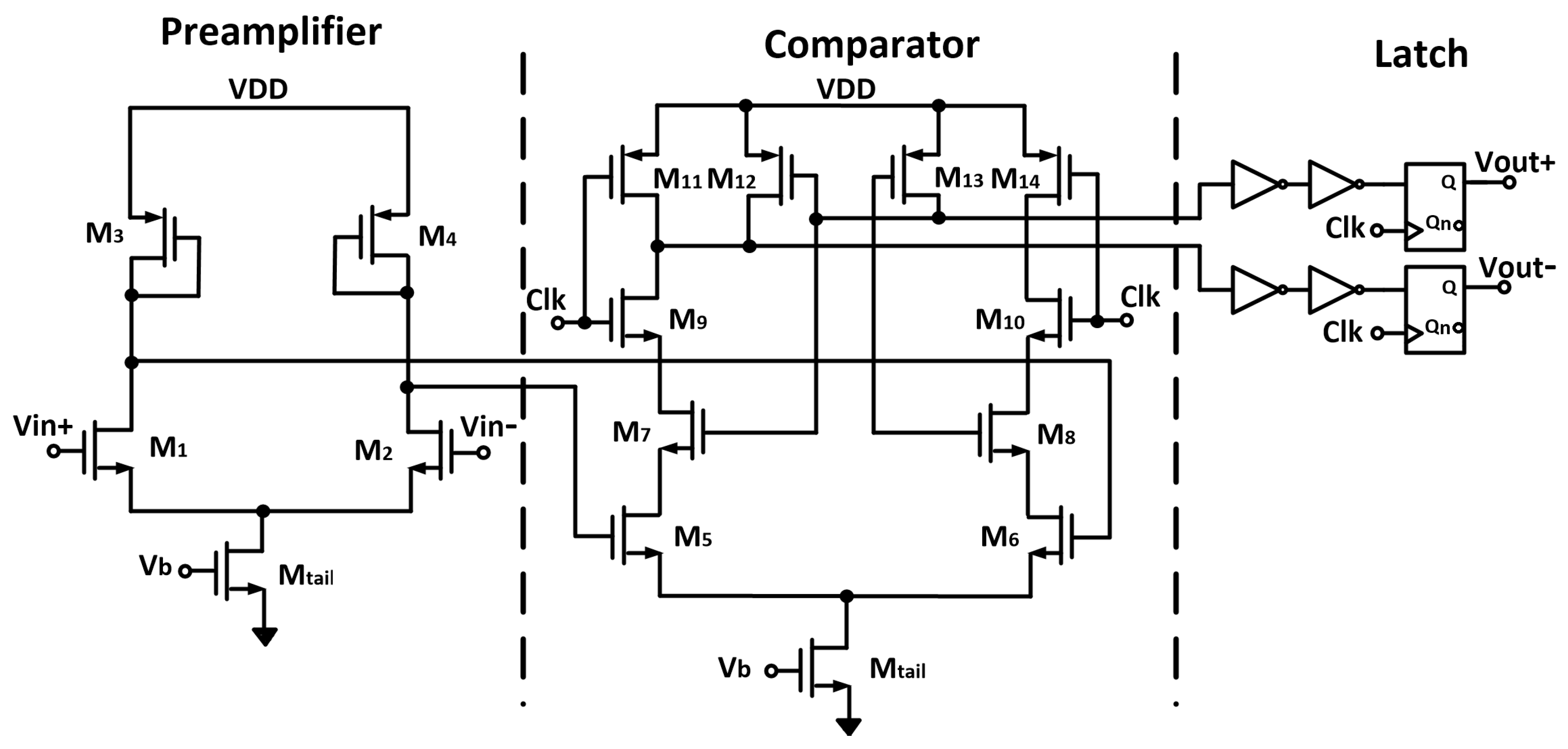

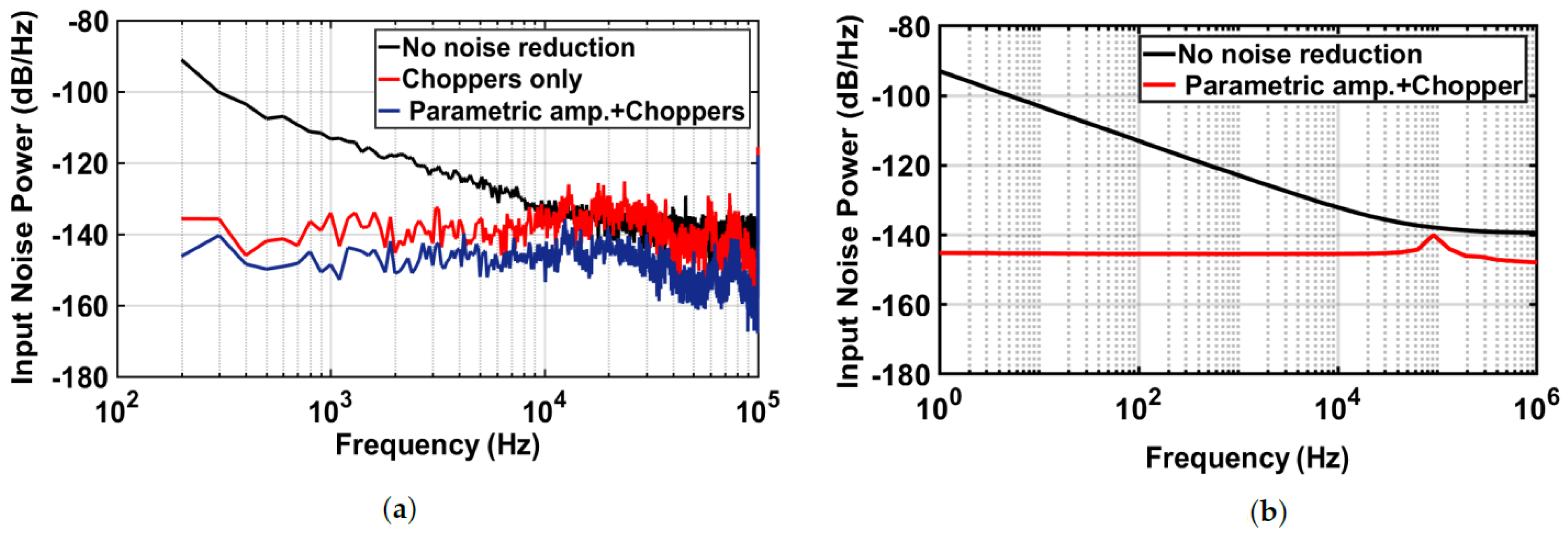

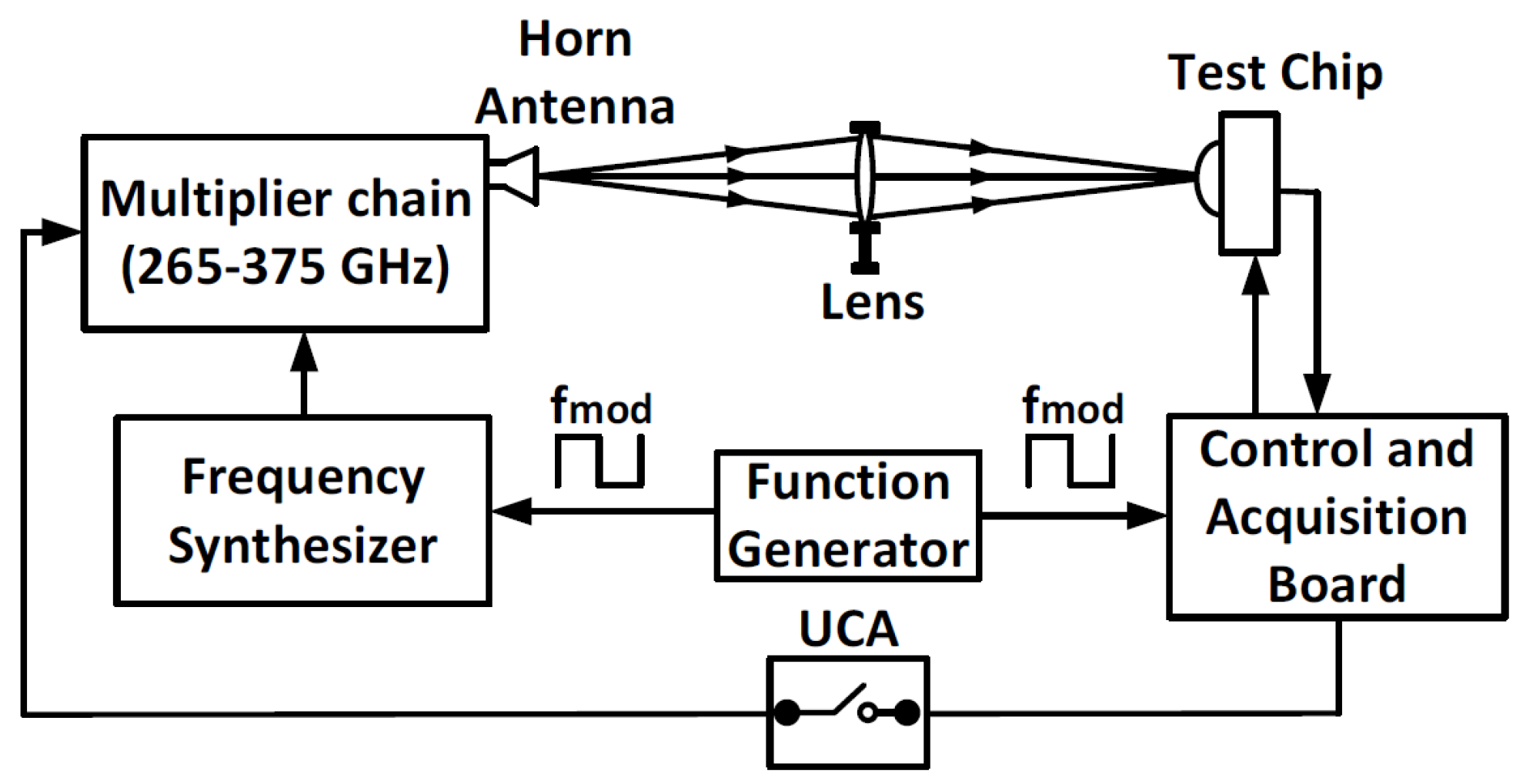

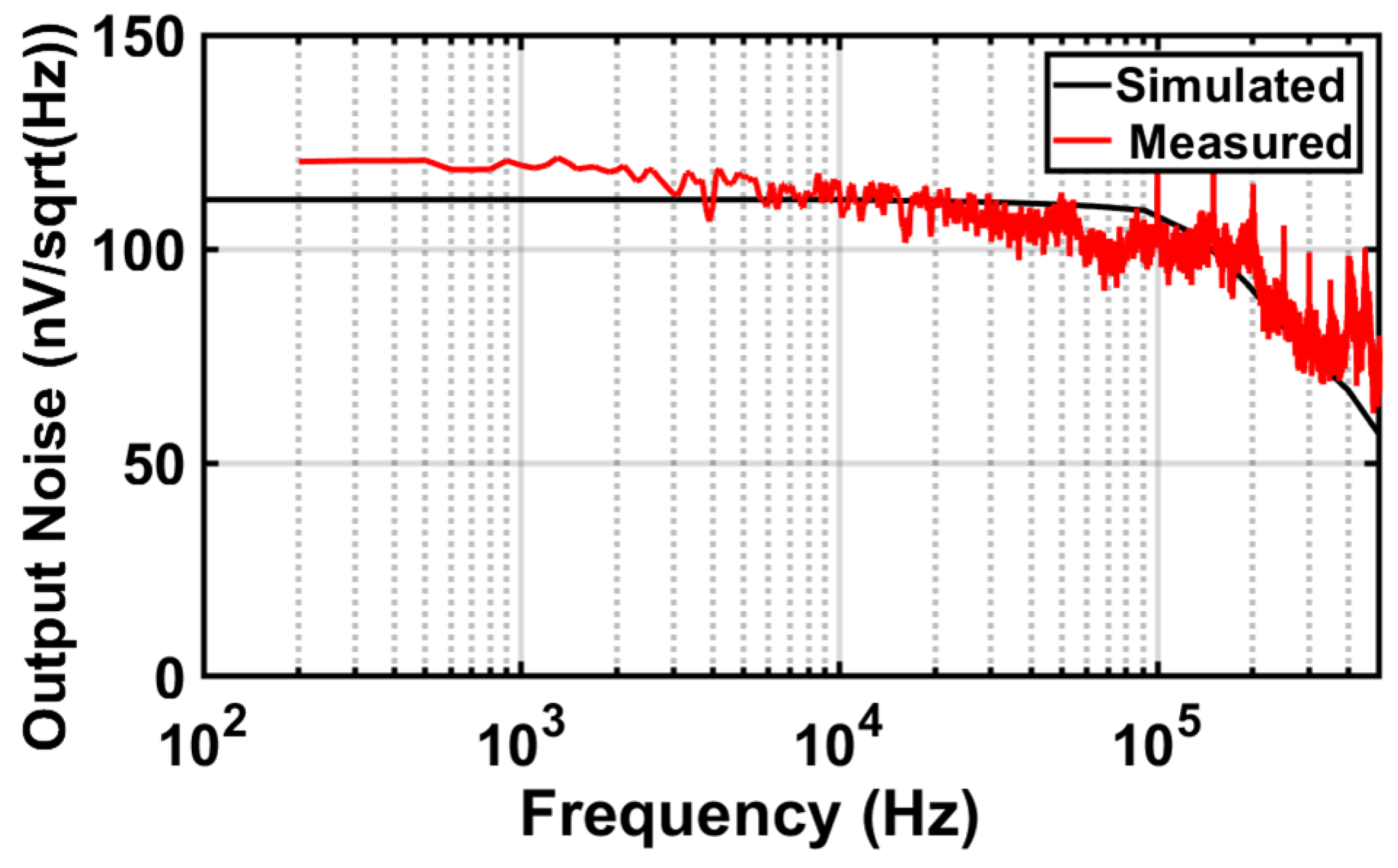

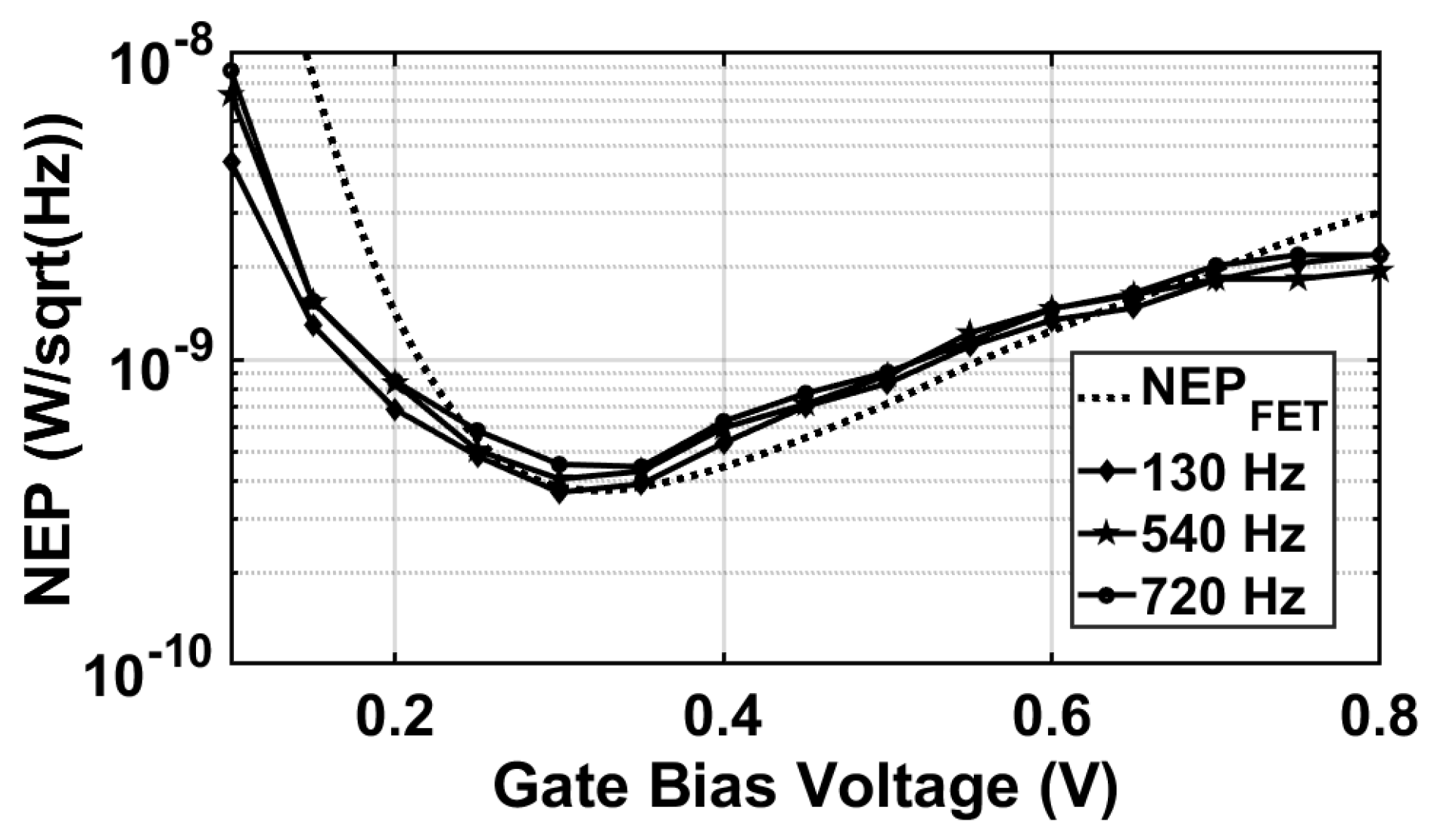


| This Work | T-TST’17 [16] | Sensor’16 [15] | JSSC’12 [14] | JSSC’09 [13] | |
|---|---|---|---|---|---|
| Process | 0.15 m | 0.18 m | 0.13 m | 65 nm | 0.25 m |
| Input-Referred Noise | 1.6 V | 2.03 V | 0.2 V | 2.45 V | - |
| Power Consumption | 80 W | - | 320 W | 2.5 W | 5.5 mW |
| Source Frequency | 325–375 GHz | 860 GHz | 270 GHz | 856 GHz | 650 GHz |
| Modulation Frequency | 10 Hz–1 kHz | 177 Hz | 156 kHz | 5 kHz | 30 kHz |
| On-chip Antenna | Bow-tie antenna | Patch antenna | Bow-tie antenna | Ring antenna | Patch antenna |
| Pixel Size | 455 × 455 m | 1330 × 440 m | 240 × 240 m | 80 × 80 m | 200 × 150 m |
| Maximum Responsivity | 783 DN/W | 3.3 kV/W | 300 kV/W | 140 kV/W | 80 kV/W |
| Minimum NEP | 376 pW/ | 106 pW/ | 533 pW | 12 nW | 300 pW/ |
| @130 Hz | @177 Hz | @156 kHz | @500 kHz | @30 kHz |
© 2018 by the authors. Licensee MDPI, Basel, Switzerland. This article is an open access article distributed under the terms and conditions of the Creative Commons Attribution (CC BY) license (http://creativecommons.org/licenses/by/4.0/).
Share and Cite
Khatib, M.; Perenzoni, M. A Low-Noise Direct Incremental A/D Converter for FET-Based THz Imaging Detectors. Sensors 2018, 18, 1867. https://doi.org/10.3390/s18061867
Khatib M, Perenzoni M. A Low-Noise Direct Incremental A/D Converter for FET-Based THz Imaging Detectors. Sensors. 2018; 18(6):1867. https://doi.org/10.3390/s18061867
Chicago/Turabian StyleKhatib, Moustafa, and Matteo Perenzoni. 2018. "A Low-Noise Direct Incremental A/D Converter for FET-Based THz Imaging Detectors" Sensors 18, no. 6: 1867. https://doi.org/10.3390/s18061867





